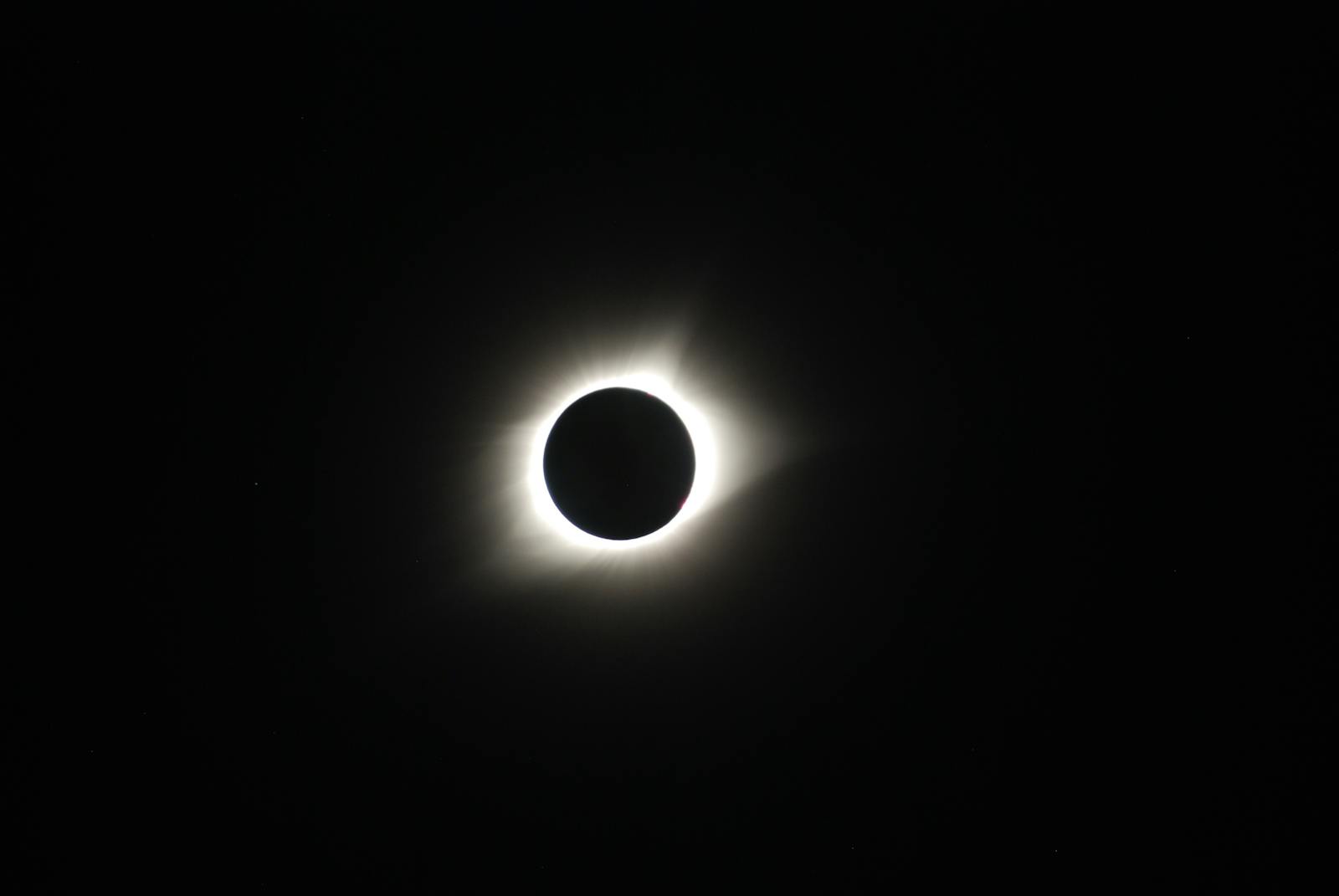Solar eclipses are one of the most awe-inspiring celestial events, captivating people worldwide as the moon passes between the Earth and the sun, temporarily blocking sunlight and casting a shadow on parts of the Earth’s surface. These extraordinary events, which occur only a few times each year, are steeped in myth and fascination. While they’re visually stunning, the science behind solar eclipses reveals a precise alignment of celestial bodies and orbital dynamics.
In this guide, we take a look into the science of solar eclipses, exploring the conditions required for their occurrence, the different types of solar eclipses, why they don’t happen more often, and the phenomena that accompany them. By understanding what causes solar eclipses, we gain insight into the intricate balance and alignment within our solar system.
The Basics of Solar Eclipses: Understanding Sun, Moon, and Earth Alignment
A solar eclipse occurs when the moon passes between the Earth and the sun, partially or completely blocking sunlight from reaching the Earth’s surface. This alignment results in a shadow cast by the moon onto the Earth, creating a zone of darkness where the eclipse is visible. However, for an eclipse to occur, several specific conditions must be met:
1. Syzygy: The Alignment of Celestial Bodies
The alignment of the sun, moon, and Earth in a straight line, known as syzygy, is essential for a solar eclipse. Without this perfect alignment, the moon would pass either above or below the sun from the Earth’s perspective, preventing it from casting a shadow onto the Earth. Syzygy allows the moon to block the sun’s light, creating the shadow necessary for an eclipse to occur. This alignment doesn’t happen every time the moon orbits Earth, which is why solar eclipses are relatively rare events.
2. The New Moon Phase
A solar eclipse can only occur during the new moon phase, when the moon is positioned between the Earth and the sun. During this phase, the side of the moon facing Earth is not illuminated by sunlight, making the moon itself invisible in the night sky. This positioning is crucial because it allows the moon to intercept sunlight before it reaches Earth. If the moon is in a different phase, such as a full or quarter moon, it’s positioned on either side of the Earth relative to the sun, making an eclipse impossible.
3. The Intersection of Orbital Planes
The orbits of the Earth and the moon are not perfectly aligned; the moon’s orbit is tilted by approximately 5 degrees relative to Earth’s orbit around the sun. This means that, most of the time, the moon passes slightly above or below the sun’s position in the sky during the new moon, and no eclipse occurs. However, at certain points in the year, called eclipse seasons, the two orbital planes intersect, creating the opportunity for a solar eclipse. When the new moon coincides with these intersection points, called nodes, an eclipse occurs.
Types of Solar Eclipses
Solar eclipses are not all the same; they vary in appearance and intensity depending on the alignment of the sun, moon, and Earth, as well as the distance of the moon from Earth. There are three primary types of solar eclipses: total, partial, and annular. Each type of eclipse provides a different viewing experience and occurs under slightly different conditions.
1. Total Solar Eclipse
A total solar eclipse is the most dramatic type of solar eclipse, in which the moon completely covers the sun, casting a shadow on the Earth. During a total eclipse, the umbral shadow (the darkest part of the shadow) falls on a small area of Earth, creating total darkness in that region for a brief period, known as totality. Observers within the path of totality experience a sudden drop in temperature, the appearance of stars, and the sight of the sun’s outer atmosphere, or corona, glowing around the moon’s silhouette. Total solar eclipses are rare and only visible along a narrow path, typically only 50 to 100 miles wide.
2. Partial Solar Eclipse
In a partial solar eclipse, only a portion of the sun is covered by the moon. Unlike total eclipses, partial eclipses do not involve complete coverage of the sun, and the sun’s brightness is only reduced rather than fully blocked. During a partial eclipse, the moon’s penumbral shadow (the lighter part of the shadow) passes over a region, causing part of the sun to appear obscured as a dark “bite” is taken out of it. Partial eclipses are more common than total eclipses and can be seen from a broader area, but they lack the dramatic effects of totality and don’t allow observers to view the corona.
3. Annular Solar Eclipse
An annular solar eclipse occurs when the moon is slightly farther from the Earth in its orbit, making it appear smaller than the sun in the sky. Because of this smaller apparent size, the moon doesn’t completely cover the sun, even at the peak of the eclipse. Instead, a ring of sunlight, known as the “ring of fire,” remains visible around the moon’s silhouette. Annular eclipses are visually striking, but they do not cause the same level of darkness as a total eclipse, and the corona is not visible. Annular eclipses occur when the moon is near its apogee (the farthest point in its orbit from Earth), reducing its ability to fully block the sun.
The Shadows of a Solar Eclipse: Umbra, Penumbra, and Antumbra
The nature of the eclipse experienced on Earth depends on the type of shadow cast by the moon. There are three main types of shadows involved in a solar eclipse: umbra, penumbra, and antumbra. Each shadow zone corresponds to a different type of eclipse experience.
1. Umbra
The umbra is the darkest part of the moon’s shadow, where the sun is entirely obscured. This shadow zone is responsible for the totality experienced during a total solar eclipse. Observers located within the umbra see the sun completely covered by the moon, resulting in darkness and a visible corona. The umbra is relatively small, only a few hundred miles wide, and it moves quickly across the Earth’s surface due to the relative motion of the moon and Earth.
2. Penumbra
The penumbra is a lighter, outer shadow where only part of the sun is obscured by the moon. Observers within the penumbral shadow experience a partial eclipse rather than a total one. The penumbra covers a much larger area than the umbra, making partial eclipses visible to more people across a wider region. Within this shadow zone, sunlight is only partially blocked, so the effects of the eclipse are less dramatic.
3. Antumbra
The antumbra is the shadow region where the moon is directly in front of the sun, but due to its distance, it appears smaller than the sun. This shadow zone results in an annular eclipse, with the ring of fire visible around the moon. Observers in the antumbral shadow see the annular eclipse, which has a unique appearance but lacks the darkened skies and visible corona of a total eclipse.
Why Don’t Solar Eclipses Happen Every Month?
Despite the new moon occurring every month, solar eclipses are relatively rare events. This infrequency is due to the tilt of the moon’s orbit relative to Earth’s orbit around the sun. The moon’s orbit is tilted about 5 degrees compared to the plane of Earth’s orbit, or the ecliptic. Because of this tilt, the moon usually passes slightly above or below the sun from our perspective on Earth, preventing the alignment needed for an eclipse.
Solar eclipses only occur when the moon crosses the ecliptic plane at the same time it is aligned between Earth and the sun. These points of intersection, known as nodes, happen only twice each year during periods called eclipse seasons. If a new moon occurs when the moon is close to a node, an eclipse can take place. The timing of eclipse seasons explains why solar eclipses don’t occur every new moon and why they follow a predictable cycle.
The Saros Cycle: Predicting Solar Eclipses
The ancient Babylonians first discovered that solar eclipses follow a pattern called the Saros cycle, which lasts approximately 18 years, 11 days, and 8 hours. The Saros cycle occurs because of the repeating geometry of the Earth, moon, and sun’s orbits. Each Saros cycle brings similar eclipses in terms of their characteristics and locations on Earth. For example, an eclipse occurring at the start of a Saros cycle will have similar conditions to the next eclipse in the cycle, though it will be shifted geographically due to Earth’s rotation.
The Saros cycle allows astronomers to predict when and where solar eclipses will occur with remarkable accuracy. Because the orbits of celestial bodies are stable and predictable, eclipse dates, durations, and paths can be calculated decades or even centuries in advance.
Phenomena Observed During a Solar Eclipse
Solar eclipses provide unique viewing experiences and offer a glimpse into astronomical phenomena that aren’t typically visible. Some of the most notable effects include:
1. The Diamond Ring Effect
Just before and after totality in a total solar eclipse, a bright point of light appears at the edge of the moon, creating an effect known as the diamond ring effect. This occurs because a small part of the sun is still visible through valleys on the moon’s surface, while most of the sun is blocked. The combination of the sun’s last visible point with the ring of the corona creates the appearance of a glowing diamond
ring.
2. Baily’s Beads
Baily’s beads are small bursts of light visible at the edge of the moon just before and after totality. These beads of light are caused by sunlight shining through valleys and gaps along the moon’s uneven surface. Named after British astronomer Francis Baily, this phenomenon adds to the uniqueness of each total eclipse, as the lunar landscape changes the appearance of Baily’s beads from one eclipse to another.
3. The Corona
During a total solar eclipse, the solar corona, or the sun’s outer atmosphere, becomes visible around the black disk of the moon. The corona emits a faint glow and consists of plasma at extremely high temperatures. The corona is normally obscured by the sun’s bright light, so a total solar eclipse provides a rare opportunity for scientists and observers to study its structure and behavior.
4. Shadow Bands
Just before and after totality, faint, rippling bands of light and shadow, known as shadow bands, may appear on the ground. These are caused by atmospheric turbulence refracting the sunlight passing through the narrow opening around the moon, creating a shimmering effect on surfaces.
The Impact of Solar Eclipses on Science and Culture
Solar eclipses have captivated human beings for centuries, inspiring both awe and scientific curiosity. Historically, eclipses were viewed as omens or signs from deities, often causing fear or reverence. Ancient civilizations recorded eclipses and developed rudimentary predictive systems based on observed cycles.
In modern times, solar eclipses have advanced scientific understanding. They provide a unique opportunity to study the sun’s corona, which is only visible during total eclipses. Research on the corona has led to insights into solar wind, magnetic fields, and the behavior of plasma. Eclipses have also contributed to groundbreaking discoveries in physics; in 1919, a solar eclipse allowed Sir Arthur Eddington to confirm Einstein’s theory of general relativity by observing the bending of starlight around the sun.
Conclusion
Solar eclipses are extraordinary phenomena that occur when the moon passes between the Earth and the sun, casting a shadow over parts of Earth. Their occurrence depends on the precise alignment of the sun, moon, and Earth, as well as the unique orbital dynamics that bring the celestial bodies into syzygy. Whether total, partial, or annular, each type of solar eclipse offers unique visual and scientific experiences that inspire wonder and contribute to our understanding of the universe. Though they are rare, predictable cycles like the Saros cycle allow us to anticipate these events, ensuring that we can continue to marvel at and study these celestial alignments for years to come.




